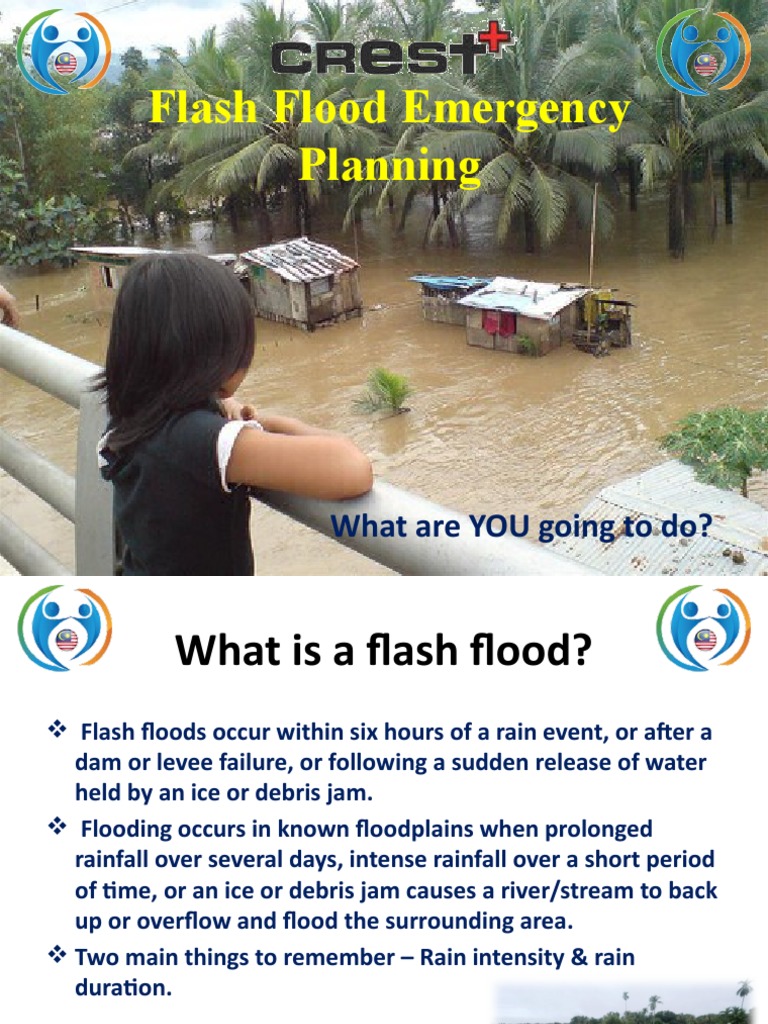What Is A Flash Flood Emergency? Preparedness And Response Strategies

Table of Contents
- Understanding Flash Flood Emergencies
- Defining Flash Floods
- Identifying Flash Flood Risks
- Preparedness Strategies for Flash Flood Emergencies
- Developing a Family Emergency Plan
- Building a Flash Flood Emergency Kit
- Home Safety Measures
- Responding to a Flash Flood Emergency
- Evacuation Procedures
- Staying Safe During a Flash Flood
- Post-Flood Safety and Recovery
- Conclusion
Understanding Flash Flood Emergencies
Defining Flash Floods
A flash flood is a rapid, powerful flood that occurs within a short period—typically six hours or less. Unlike regular floods, which develop gradually over days or weeks, flash floods have a sudden and overwhelming onset, making them extremely dangerous. They are often caused by intense, localized rainfall, dam or levee failures, or the rapid melting of snow. The National Weather Service reports thousands of flash flood events annually in the United States alone, resulting in significant property damage and loss of life.
- Definition of flash flood: A rapid and sudden rise in water level, typically within six hours or less.
- Typical causes: Heavy or prolonged rainfall, dam or levee failures, sudden release of water from reservoirs, rapid snowmelt.
- Speed of onset: Extremely rapid, often with little to no warning.
- Common geographic locations: Mountainous regions, areas with poor drainage, urban areas with inadequate infrastructure, arid regions with intense, infrequent rainfall.
Identifying Flash Flood Risks
Several factors increase the risk of flash flooding in specific areas. Understanding these risks allows for better preparedness and mitigation efforts.
- Geographic factors: Steep slopes, narrow canyons, areas with limited vegetation, and regions with impermeable soil.
- Weather patterns: Monsoons, thunderstorms, hurricanes, and rapid snowmelt events.
- Human impact: Deforestation, urbanization (which increases runoff and reduces water absorption), and inadequate drainage systems.
- Signs of impending flash floods: Rapidly rising water levels in streams, rivers, or creeks; strong and unusually fast currents; a noticeable increase in the volume of water; unusual sounds like rushing water or debris; and official flood warnings issued by weather authorities.
Preparedness Strategies for Flash Flood Emergencies
Developing a Family Emergency Plan
A comprehensive family emergency plan is paramount. This plan should include:
- Establish communication methods: Designate a primary and secondary contact person outside the affected area. Establish a meeting point in case family members are separated. Text messaging often works better than phone calls during emergencies.
- Designate evacuation routes: Identify multiple escape routes from your home and neighborhood, considering potential road closures.
- Create a go-bag: Pack essential supplies such as water (at least one gallon per person per day for several days), non-perishable food, a first-aid kit, a flashlight with extra batteries, a battery-powered radio, essential medications, copies of important documents, and comfortable shoes.
- Familiarize family members: Regularly review the plan with all family members, ensuring everyone understands their roles and responsibilities.
Building a Flash Flood Emergency Kit
Your flash flood emergency kit should contain:
- Water: At least one gallon of water per person per day for several days.
- Non-perishable food: Energy bars, canned goods, dried fruit, etc.
- First-aid kit: Including bandages, antiseptic wipes, pain relievers, and any necessary prescription medications.
- Flashlight and extra batteries: Essential for navigating in low-light conditions.
- Battery-powered radio: To stay updated on weather alerts and emergency information.
- Whistle: To signal for help.
- Important documents: Copies of identification, insurance policies, and medical information.
Home Safety Measures
Implementing preventative home safety measures can significantly reduce the impact of a flash flood:
- Improve drainage: Clear gutters and downspouts regularly to ensure efficient water runoff.
- Protect valuables: Elevate furniture and appliances, or use waterproof containers to protect them from floodwaters. Consider waterproofing valuable documents.
- Identify flood-prone areas: Know which areas of your home are most susceptible to flooding and take appropriate precautions.
- Explore flood insurance options: Consider purchasing flood insurance, as it's often not included in standard homeowner's insurance policies.
Responding to a Flash Flood Emergency
Evacuation Procedures
When a flash flood warning is issued, act swiftly:
- Follow official evacuation orders: Obey instructions from emergency officials immediately.
- Use designated evacuation routes: Avoid flooded areas and follow recommended routes.
- Secure your home: Turn off utilities (gas, electricity) if it's safe to do so.
- Move valuables to higher ground: If time permits, move important items to upper floors or elevated areas.
- Assist vulnerable neighbors: Help elderly or disabled neighbors evacuate if possible and safe.
Staying Safe During a Flash Flood
During a flash flood, prioritize safety:
- Never drive or walk through floodwaters: Even shallow water can conceal dangerous currents and debris.
- Seek shelter on higher ground: Find a sturdy structure on higher ground, such as a second floor or elevated area.
- Avoid contact with floodwater: Floodwater is often contaminated and can cause disease. Avoid contact with electrical hazards as well.
- Stay informed: Continue to monitor weather reports and official updates for information on the flood's progression.
Post-Flood Safety and Recovery
After the flood subsides:
- Check for structural damage: Assess your home for damage and contact a qualified professional if necessary.
- Avoid contact with floodwater: Floodwater remains contaminated, posing health risks.
- Report damage to authorities: Contact your local emergency services and insurance provider to report any damage.
- Contact insurance providers: File claims promptly.
- Access available relief and support programs: Seek assistance from government agencies and non-profit organizations.
Conclusion
Flash flood emergencies are unpredictable and dangerous. Understanding the risks, developing a robust preparedness plan, and knowing how to respond effectively are crucial for minimizing risk and damage. Remember to create a comprehensive flash flood emergency plan, including evacuation routes, a well-stocked emergency kit, and home safety measures. Stay informed about weather alerts and warnings from reliable sources like the National Weather Service and FEMA. Don't wait for a flash flood emergency – prepare now! [Link to National Weather Service] [Link to FEMA]

 Latest F1 News Mercedes Investigating Lewis Hamilton Update
Latest F1 News Mercedes Investigating Lewis Hamilton Update
 Louisiana Inmates Hair Trimmer Escape Attempt From New Orleans Jail
Louisiana Inmates Hair Trimmer Escape Attempt From New Orleans Jail
 Kiefer Sutherland To Honor Father Donald At Canadian Screen Awards
Kiefer Sutherland To Honor Father Donald At Canadian Screen Awards
 Your Guide To The Top 10 Tv Shows And Streaming Options This Thursday
Your Guide To The Top 10 Tv Shows And Streaming Options This Thursday
 Soerloth La Liga Da Doert Golle Basladi
Soerloth La Liga Da Doert Golle Basladi
